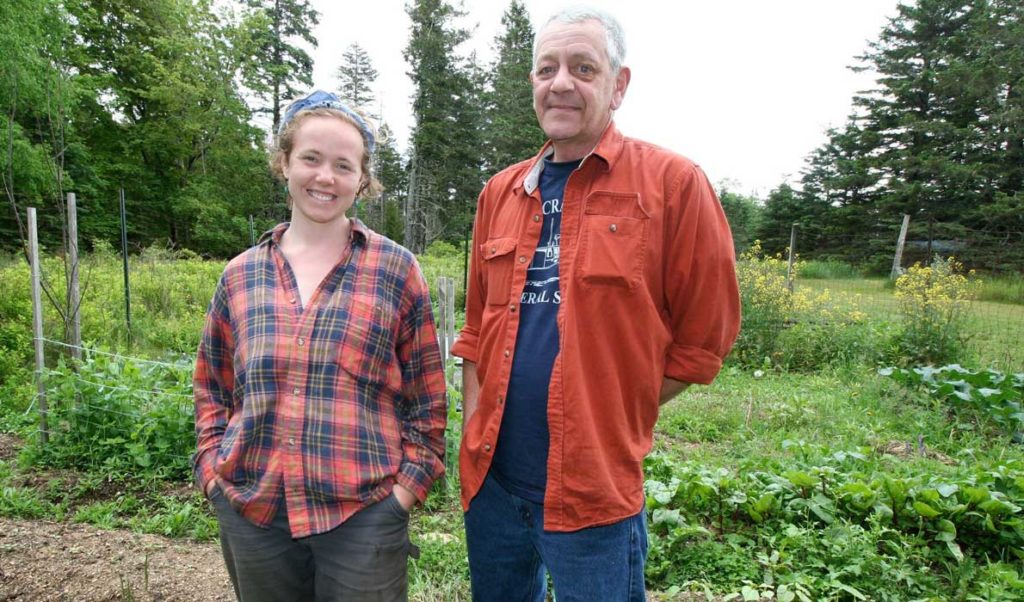Here and there around Great Cranberry Island, a flock of geese runs as one around its pen, a trio of sheep explores a grassy apple orchard, a brace of goats peer through a fence, and a whole lot of gardens in various sizes and configurations bloom with delicious vegetables and fruits destined for summer’s farm stands.
All represent a renaissance of agricultural activity that evokes the 18th and 19th centuries, when animal husbandry, orchards and farming were part of everyday island life.
The agricultural heritage here is poorly documented, but there are clues all around, says Jessi Duma, an Island Institute Fellow, who’s researching the subject and mounted an exhibit at Great Cranberry’s Preble-Marr Historical Museum.
In 1860, there were 19 farms on the Cranberry Isles. Families grew hay, potatoes, and raised animals. Livestock included cows, oxen, sheep and chickens. Some had flocks of a hundred or more sheep. Cows produced hundreds of pounds of butter.
These days, folks are reestablishing these practices. Four transplants—Sarah McCracken, Duma, Kayla Gagnon and Page Hill—have developed an Island Ecology Farming Project, resurrecting old gardens and setting up a successful farm stand.
Islander Mark Alley recalls how much his father, a lobsterman, used to enjoy his garden.
“He’d come out here and pull weeds and tie strings. He loved it. But he died in 2000, and I let the garden go. When Sarah called me I said, ‘Yep, go for it.’ I was glad to see things growing again.”
“The fencing was all here, so we stood it back up,” says Duma. “And it’s really good soil.”
Duma points here and there.
“We have potatoes in these two beds, cilantro, onions back there, kale, oregano, beans, spinach—which is bolting—peas, cucumbers, cabbage back there. There’s broccoli, zucchini, lettuce, arugula and tomatoes. And here’s some calendula. And we still have a lot of beds to put in.”
A little way down the road is the Preble House, standing on a hilltop above Preble Cove. It was built in 1826 by Samuel Spurling and his brother-in-law Capt. Samuel Hadlock Jr., an Arctic adventurer and traveling showman who perished at sea.
The house’s second owner, William Pitt Preble, was married to Hadlock’s sister. Like most people of his day, says Duma, Preble was an island “everyman”—farmer, merchant, town official, postmaster. The house eventually went to the McFarlane family. Now the McFarlane’s garden is set in the midst of a lush lupine field, within sight of a stump that is the last remnant of an apple orchard and pasturage where scores of sheep once roamed.
“Who could imagine a better place to spend time in the evening?” says Duma, gazing out on the water.
There are numerous other agri-activities and tales of people helping to maintain them. A primary inspiration is summer resident Janice Murch, who keeps Shetland sheep, ducks, chickens and rabbits, and is turning a spruce forest into an apple orchard, planting cider varieties and employing young adults as gardeners/farmhands.
Wendy Rackcliffe keeps ducks, geese, turkeys, angora rabbits and fluffy white chickens with feathers that look as soft as bunny fur. Sam Donald lets the gardeners use part of his land for composting. Blair Colby brings his equipment to bear for tilling and haying. A summer resident donated money to purchase a greenhouse to start seeds.
The first thing Rosalie Kell did when she moved into the Rice House last year was plant a garden and start a vermiculture experiment out back.
The Sumner family moved to Great Cranberry from Fancy Gap, Va., last year. Ben Sumner’s father followed with two of the family’s four LaMancha goats, a high-quality milking breed.
“The big thing up here is trying to feed them through the winter without having to barge in hay,” says Sumner, who’s looking in on the livestock at the moment, with two of his children—Kariah, 8, and Audrey, 1. “That was successful.”
The family also keeps a vegetable garden.
“Anything you can do to save getting it on the boat is a big help,” he says. “We just try to slide in where we can and adapt where we can. And so far it’s been real good.”
Duma’s fellowship is supported by the Fund for Maine Islands, a partnership between the Island Institute, publisher of The Working Waterfront, and College of the Atlantic.





